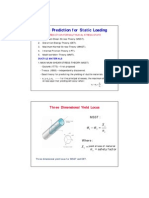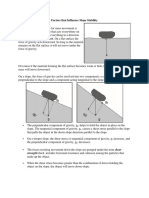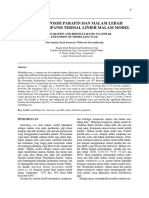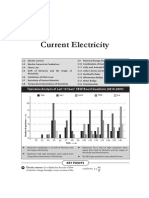Maxwell Relations
Maxwell Relations
Uploaded by
Raghav AgrawalCopyright:
Available Formats
Maxwell Relations
Maxwell Relations
Uploaded by
Raghav AgrawalOriginal Description:
Copyright
Available Formats
Share this document
Did you find this document useful?
Is this content inappropriate?
Copyright:
Available Formats
Maxwell Relations
Maxwell Relations
Uploaded by
Raghav AgrawalCopyright:
Available Formats
Maxwell relations
Maxwell relations
Thermodynamics
The classical Carnot heat engine
Maxwell's relations are a set of equations in thermodynamics which are derivable from the definitions of the thermodynamic potentials. These relations are named for the nineteenth-century physicist James Clerk Maxwell.
Equation
The Maxwell relations are statements of equality among the second derivatives of the thermodynamic potentials. They follow directly from the fact that the order of differentiation of an analytic function of two variables is irrelevant. If is a thermodynamic potential and xi and xj are two different natural variables for that potential, then the Maxwell relation for that potential and those variables is: Maxwell relations (general) where the partial derivatives are taken with all other natural variables held constant. It is seen that for every thermodynamic potential there are n(n 1)/2 possible Maxwell relations where n is the number of natural variables for that potential.
The four most common Maxwell relations
The four most common Maxwell relations are the equalities of the second derivatives of each of the four thermodynamic potentials, with respect to their thermal natural variable (temperature T; or entropy S) and their mechanical natural variable (pressure P; or volume V):
Maxwell's relations (common)
where the potentials as functions of their natural thermal and mechanical variables are the internal energy U(S, V), Enthalpy H(S, P), Helmholtz free energy A(T, V) and Gibbs free energy G(T, P). The thermodynamic square can be used as a mnemonic to recall and derive these relations.
Maxwell relations
Derivation
Maxwell relations are based on simple partial differentiation rules, in particular the total differential of a function and the symmetry of evaluating second order partial derivatives.
Derivation Derivation of the Maxwell relations can be deduced from the differential forms of the thermodynamic potentials:
These equations resemble total differentials of the form
And indeed, it can be shown for any equation of the form
that
Consider, as an example, the equation
. We can now immediately see that
Since we also know that for functions with continuous second derivatives, the mixed partial derivatives are identical (Symmetry of second derivatives), that is, that
we therefore can see that
and therefore that
Each of the four Maxwell relationships given above follows similarly from one of the Gibbs equations.
Extended derivation Combined form first and second law of thermodynamics, (Eq.1) U, S, and V are state functions. Let,
Maxwell relations Substitute them in Eq.1 and one gets,
And also written as,
comparing the coefficient of dx and dy, one gets
Differentiating above equations by y, x respectively (Eq.2) and (Eq.3) U, S, and V are exact differentials, therefore,
Subtract eqn(2) and (3) and one gets
Note: The above is called the general expression for Maxwell's thermodynamical relation. Maxwell's first relation Allow x = S and y = V and one gets
Maxwell's second relation Allow x = T and y = V and one gets
Maxwell's third relation Allow x = S and y = P and one gets
Maxwell's fourth relation
Maxwell relations Allow x = T and y = P and one gets
Maxwell's fifth relation Allow x = P and y = V =1 Maxwell's sixth relation Allow x = T and y = S and one gets =1
General Maxwell relationships
The above are not the only Maxwell relationships. When other work terms involving other natural variables besides the volume work are considered or when the number of particles is included as a natural variable, other Maxwell relations become apparent. For example, if we have a single-component gas, then the number of particles N is also a natural variable of the above four thermodynamic potentials. The Maxwell relationship for the enthalpy with respect to pressure and particle number would then be:
where is the chemical potential. In addition, there are other thermodynamic potentials besides the four that are commonly used, and each of these potentials will yield a set of Maxwell relations. Each equation can be re-expressed using the relationship
which are sometimes also known as Maxwell relations.
External links
a partial derivation of Maxwell's relations [1]
References
[1] http:/ / theory. ph. man. ac. uk/ ~judith/ stat_therm/ node48. html
Article Sources and Contributors
Article Sources and Contributors
Maxwell relations Source: http://en.wikipedia.org/w/index.php?oldid=569416784 Contributors: Apyule, Charles Matthews, Complexica, DARTH SIDIOUS 2, Dhollm, Dirac66, Edsanville, Eliyak, Entropy, Epolk, F=q(E+v^B), Fibonacci, Giftlite, Gogobera, Headbomb, Hydrogen Iodide, Icairns, Inutilisable, Japanese Searobin, Liuxunchen, Loodog, MMKO, Machina Lucis, MagiMaster, Makeemlighter, Michael Hardy, Nanomage, PAR, PV=nRT, Pmetzger, Richie, RoB, Screamerman18, Stallionz, Thorwald, Towerman86, Vinayakrishnanmb, WeiWuHere, Wranadu2, , 76 anonymous edits
Image Sources, Licenses and Contributors
File:Carnot heat engine 2.svg Source: http://en.wikipedia.org/w/index.php?title=File:Carnot_heat_engine_2.svg License: Public Domain Contributors: Eric Gaba (Sting - fr:Sting)
License
Creative Commons Attribution-Share Alike 3.0 Unported //creativecommons.org/licenses/by-sa/3.0/
You might also like
- RS Moahmed Bakri OsmanDocument27 pagesRS Moahmed Bakri Osmanbakri OmanNo ratings yet
- Tutorial 1 - AirDocument2 pagesTutorial 1 - AirAndrew RobertsonNo ratings yet
- Reactors Design, Adiabatic and Non - Adiabatic ProcessesDocument30 pagesReactors Design, Adiabatic and Non - Adiabatic ProcessesRodrigo PicazoNo ratings yet
- Dissolution of Benzoic AcidDocument2 pagesDissolution of Benzoic AcidAngela Calatayud100% (1)
- CSTRDocument12 pagesCSTRsamueloNo ratings yet
- Michelsen (1990) - Method For Incorporating Excess Gibbs Energy Modified Eos.Document12 pagesMichelsen (1990) - Method For Incorporating Excess Gibbs Energy Modified Eos.Ariel Hernández SepúlvedaNo ratings yet
- CHEM 212: Phase EquilibriaDocument68 pagesCHEM 212: Phase EquilibriaSerwan BamerniNo ratings yet
- Chapter 3: Properties of A Pure Substance: ThermodynamicsDocument62 pagesChapter 3: Properties of A Pure Substance: ThermodynamicsAnurag PanditNo ratings yet
- Lecture 2 - Phase EquilibriaDocument57 pagesLecture 2 - Phase Equilibria20-02259No ratings yet
- Thermodynamics Worked Examples PDFDocument20 pagesThermodynamics Worked Examples PDFJoshua Edokpayi100% (1)
- Chemical Potential in Mixtures: Partial Molar Quantities Thermodynamics of Mixing The Chemical Potentials of LiquidsDocument61 pagesChemical Potential in Mixtures: Partial Molar Quantities Thermodynamics of Mixing The Chemical Potentials of Liquidsjayven minguillanNo ratings yet
- Partial Molar Heat Content and Chemical Potential, Significance and Factors Affecting, Gibb's-Duhem EquationDocument11 pagesPartial Molar Heat Content and Chemical Potential, Significance and Factors Affecting, Gibb's-Duhem EquationRhakhoNo ratings yet
- Adsorption Sample ProblemsDocument5 pagesAdsorption Sample ProblemsAshish RanjanNo ratings yet
- Phase Equilibrium Diagram': Phase, Phase Transformation, Phase Diagram, Phase Rule & Degress of FreedomDocument20 pagesPhase Equilibrium Diagram': Phase, Phase Transformation, Phase Diagram, Phase Rule & Degress of FreedomGlesie Devara CabacangNo ratings yet
- Tutorial Particlesizeand Distribution 2019Document2 pagesTutorial Particlesizeand Distribution 2019GauravKinngNo ratings yet
- Assignment 4 - 180107058 PDFDocument4 pagesAssignment 4 - 180107058 PDFshubhamNo ratings yet
- Cheng 323 Chap 4Document82 pagesCheng 323 Chap 4Faisal Mumtaz100% (2)
- Solids HomeworkDocument20 pagesSolids HomeworkindiomajaderoNo ratings yet
- Conduction Heat Transfer Arpaci PDFDocument551 pagesConduction Heat Transfer Arpaci PDFKimNo ratings yet
- Convective Mass TransferDocument13 pagesConvective Mass TransferAriadne ChuaNo ratings yet
- Solution ManualDocument124 pagesSolution ManualMahmoud AsmidaNo ratings yet
- Tutorial 2Document2 pagesTutorial 2Angelina PutriNo ratings yet
- Trapezoidal RuleDocument10 pagesTrapezoidal RuleChristed Aljo BarrogaNo ratings yet
- Kunii Levenspiel 1991Document6 pagesKunii Levenspiel 1991papapa14No ratings yet
- Boundary LayerDocument8 pagesBoundary LayerVenkatarao ChukkaNo ratings yet
- Reaction Kinetics and Scale-Up of Catalytic ProcessesDocument6 pagesReaction Kinetics and Scale-Up of Catalytic Processessatishchemeng100% (1)
- Convective Mass Transfer PDFDocument14 pagesConvective Mass Transfer PDFAnonymous 4XZYsImTW5100% (1)
- Mass Transfer NotesDocument66 pagesMass Transfer NotesJabulani Jays MadonselaNo ratings yet
- W6 Toxic Release and Dispersion Models UlearnDocument61 pagesW6 Toxic Release and Dispersion Models UlearnFakhrulShahrilEzanieNo ratings yet
- Failure Prediction-Static-22Document8 pagesFailure Prediction-Static-22Ramonaldi RadjabNo ratings yet
- Chemical Engineering in Practise 3: Fluidised BedsDocument12 pagesChemical Engineering in Practise 3: Fluidised BedsYaz Swedan100% (1)
- EG55P7 Tutorial 05 SolutionsDocument5 pagesEG55P7 Tutorial 05 SolutionsAndrew RobertsonNo ratings yet
- Solution.: L and Width W. The Liquid Flows As A Falling Film With Negligible Rippling Under The Influence of Gravity. EndDocument4 pagesSolution.: L and Width W. The Liquid Flows As A Falling Film With Negligible Rippling Under The Influence of Gravity. EndChintiaNo ratings yet
- All ProblemsDocument29 pagesAll Problemsahmed hatemNo ratings yet
- The Settling Stone ChamberDocument3 pagesThe Settling Stone ChamberererdNo ratings yet
- EKC314 Transport PhenomenaDocument53 pagesEKC314 Transport PhenomenaPreeti SinghNo ratings yet
- Kinetic Theory of GasesDocument8 pagesKinetic Theory of GasesDev MaheshwariNo ratings yet
- 3 - Vle in A Binary Mixture - 2Document22 pages3 - Vle in A Binary Mixture - 2Faisal El HakimNo ratings yet
- CHE4162 Particle Technology November 2010 Exam SolutionsDocument14 pagesCHE4162 Particle Technology November 2010 Exam SolutionsPa1 Kumar M100% (1)
- Week7 (Wed Mar 03-Single Particle in Fluid (Students Notes)Document21 pagesWeek7 (Wed Mar 03-Single Particle in Fluid (Students Notes)Julie Anne CristalesNo ratings yet
- Equation of State PDFDocument84 pagesEquation of State PDFAnubhav SinghNo ratings yet
- Multiple Particle SystemsDocument21 pagesMultiple Particle SystemsMD IMRAN HOSSENNo ratings yet
- HT UnaDocument128 pagesHT UnaChetana PatilNo ratings yet
- Mass Transfer Coefficient Class NoteDocument22 pagesMass Transfer Coefficient Class NoteNayan Halder100% (2)
- Thermodynamics Question Set ADocument4 pagesThermodynamics Question Set AVivek Negi100% (1)
- Separation Processes HandoutDocument10 pagesSeparation Processes Handoutkiran367No ratings yet
- Mto Lab Manuals - All ExperimentsDocument121 pagesMto Lab Manuals - All ExperimentsAnmol JainNo ratings yet
- Material Balance in Steady and Unsteady SyatemsDocument11 pagesMaterial Balance in Steady and Unsteady SyatemsRanjeet SinghNo ratings yet
- Example 18 Intro Heat TransferDocument11 pagesExample 18 Intro Heat TransferDinkar Bharti100% (1)
- Chapter 13. Interphase Transport in Non-Isothermal SystemsDocument21 pagesChapter 13. Interphase Transport in Non-Isothermal SystemsEndarto YudoNo ratings yet
- Lecture 2 MassMicroDocument25 pagesLecture 2 MassMicroPelin KınıkNo ratings yet
- r05220802 Chemical Engineering Thermodynamics IDocument6 pagesr05220802 Chemical Engineering Thermodynamics ISRINIVASA RAO GANTANo ratings yet
- Real GasesDocument13 pagesReal GasesEve Fatima SaubonNo ratings yet
- Intrinsic and Global Reaction Rate of Methanol Dehydration Over G Al2O3 Pellets 1992 Industrial and Engineering Chemistry Research1992Document7 pagesIntrinsic and Global Reaction Rate of Methanol Dehydration Over G Al2O3 Pellets 1992 Industrial and Engineering Chemistry Research1992pannita.kNo ratings yet
- Mass Transfer CoefficientsDocument12 pagesMass Transfer CoefficientsAkash Goyal100% (1)
- ملزمة الفصل الاول المعدلة من قبل الدكتورة مع الامثلةDocument55 pagesملزمة الفصل الاول المعدلة من قبل الدكتورة مع الامثلةAl-Hassan NeimaNo ratings yet
- Introductory Applications of Partial Differential Equations: With Emphasis on Wave Propagation and DiffusionFrom EverandIntroductory Applications of Partial Differential Equations: With Emphasis on Wave Propagation and DiffusionNo ratings yet
- Emergency Relief System Design Using DIERS Technology: The Design Institute for Emergency Relief Systems (DIERS) Project ManualFrom EverandEmergency Relief System Design Using DIERS Technology: The Design Institute for Emergency Relief Systems (DIERS) Project ManualRating: 4 out of 5 stars4/5 (1)
- Chemical Engineering Dynamics: An Introduction to Modelling and Computer SimulationFrom EverandChemical Engineering Dynamics: An Introduction to Modelling and Computer SimulationNo ratings yet
- AdaniDocument3 pagesAdaniRaghav AgrawalNo ratings yet
- Oil and Gas ProcessingDocument3 pagesOil and Gas ProcessingRaghav Agrawal100% (2)
- Media Release For Immediate ReleaseDocument10 pagesMedia Release For Immediate ReleaseRaghav AgrawalNo ratings yet
- Assinment 1Document2 pagesAssinment 1Raghav AgrawalNo ratings yet
- Be A Success, Join IT&S: Enterprise ArchitectureDocument2 pagesBe A Success, Join IT&S: Enterprise ArchitectureRaghav AgrawalNo ratings yet
- Come New 3 Lab FitDocument4 pagesCome New 3 Lab FitRaghav AgrawalNo ratings yet
- Promotional Offer of 20% Special Discount On Sale Price of EVDO Data CardDocument1 pagePromotional Offer of 20% Special Discount On Sale Price of EVDO Data CardRaghav AgrawalNo ratings yet
- Chem o Phila ElimsDocument8 pagesChem o Phila ElimsRaghav AgrawalNo ratings yet
- Response Surface Methodology (RSM)Document8 pagesResponse Surface Methodology (RSM)Raghav AgrawalNo ratings yet
- MAT Analysis, February 2010Document4 pagesMAT Analysis, February 2010Raghav AgrawalNo ratings yet
- Mixing F Luids: ChapterightDocument49 pagesMixing F Luids: Chapterightvane-16No ratings yet
- Shyam Bihari Lal Engineering Mechanics Notes: 1. Resultant of A Force SystemDocument6 pagesShyam Bihari Lal Engineering Mechanics Notes: 1. Resultant of A Force Systemlatendra kumar srivastavNo ratings yet
- Msds Sigma Ecofleet 530 (Ecol Ha)Document8 pagesMsds Sigma Ecofleet 530 (Ecol Ha)kumarNo ratings yet
- Argonne HistoryDocument1 pageArgonne HistoryDavid NyeNo ratings yet
- Factors That Influence Slope StabilityDocument21 pagesFactors That Influence Slope StabilityJames LaurentNo ratings yet
- Poster Program - II - Apmas Enefm 2019Document9 pagesPoster Program - II - Apmas Enefm 2019Bel BelNo ratings yet
- ISO 6059-1984 ScanDocument6 pagesISO 6059-1984 Scancornelian.terlanNo ratings yet
- 3 JAppliedSpectrosDocument8 pages3 JAppliedSpectrosYến NgọcNo ratings yet
- Chap 8 Fatiguepart 1Document32 pagesChap 8 Fatiguepart 1Abu Salman Said100% (1)
- Polar Iz AbilityDocument5 pagesPolar Iz AbilityManaviNo ratings yet
- International Standard Atmosphere (ISA)Document38 pagesInternational Standard Atmosphere (ISA)rahulsamyal100% (1)
- Efek Komposisi Parafin Dan Malam Lebah Terhadap Ekspansi Termal Linier Malam ModelDocument4 pagesEfek Komposisi Parafin Dan Malam Lebah Terhadap Ekspansi Termal Linier Malam ModelBelinda NasiaNo ratings yet
- MBE3010 - Brakes and ClutchesDocument29 pagesMBE3010 - Brakes and ClutchesShafi NibrajNo ratings yet
- CHEM1380B PPT4 - Chemical Reactions Introduction 2015Document37 pagesCHEM1380B PPT4 - Chemical Reactions Introduction 2015ctyuNo ratings yet
- HeliumDocument1 pageHeliumzidaaanNo ratings yet
- Production of R-134a: BackgroundDocument12 pagesProduction of R-134a: Backgroundmoh1234bukNo ratings yet
- K.Mohammed RafiDocument3 pagesK.Mohammed RafiAnonymous AkH3e7LNo ratings yet
- Phase TransformationDocument50 pagesPhase TransformationJitenderNo ratings yet
- Iso TR 00945-3-2016Document50 pagesIso TR 00945-3-2016SEDEF IMPEXNo ratings yet
- Pyrotek - SIVEX - Ceramic FoamDocument2 pagesPyrotek - SIVEX - Ceramic FoamajoilhamNo ratings yet
- Taxonomy of Haematococcus PluvialisDocument2 pagesTaxonomy of Haematococcus PluvialisKomathi BalasupramaniamNo ratings yet
- Epri PaperDocument8 pagesEpri Paper3319826No ratings yet
- Is 12735 Wire Rope SlingsDocument14 pagesIs 12735 Wire Rope SlingsMD ParthiNo ratings yet
- 氯化聚丙烯 MSDSDocument5 pages氯化聚丙烯 MSDSThảo ThuNo ratings yet
- Đề thi thử vào 10 chuyên Anh số 17Document14 pagesĐề thi thử vào 10 chuyên Anh số 17Phạm Đức DuyNo ratings yet
- Current Electricty by Baba GangDocument7 pagesCurrent Electricty by Baba GangKushagra RajNo ratings yet
- Gen Chem 1 Q1 M4Document9 pagesGen Chem 1 Q1 M4Joselito UbaldoNo ratings yet
- Turorial-1 - Cl302 Fogler Solution PDFDocument3 pagesTurorial-1 - Cl302 Fogler Solution PDFshubhamNo ratings yet
- Docshare - Tips - Bs en 459 2 2001 PDFDocument44 pagesDocshare - Tips - Bs en 459 2 2001 PDFkhun_kae100% (1)



































































































